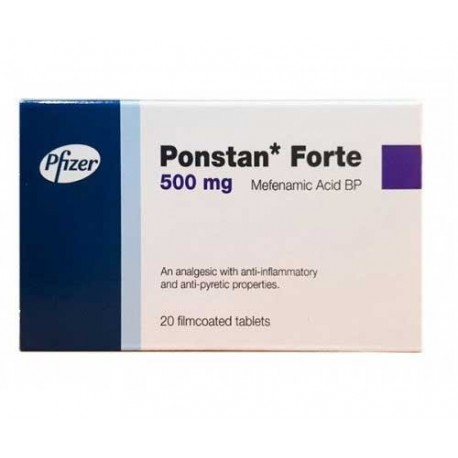 View larger
View larger Ponstan Fort (mefenamic acid ) 500 Mg 20 Tablets
PNS4563
New product
BUY MORE PAY LESS
| Quantity | Discount | |
|---|---|---|
| 2 | 5% | |
| 3 | 10% | |
| 4 | 15% | |
| 5 | 20% |
Volume discounts
| Quantity | Discount | You Save |
|---|---|---|
| 2 | 5% | Up to $2.60 |
| 3 | 10% | Up to $7.80 |
| 4 | 15% | Up to $15.60 |
| 5 | 20% | Up to $26.00 |
More info
PONSTAN FORTE 500 mg film tablet It is taken orally.
Active ingredient
mefenamic acid
Excipients
Methyl cellulose, pregelatinized starch, corn starch, sodium lauryl sulfate, microcrystalline cellulose, anhydrous colloidal silicon, magnesium stearate, talc, methylhydroxypropylcellulose, titanium dioxide, macrogol 6000, yellow iron oxide, vanillin
1. What is PONSTAN FORT and what is it used for?
PONSTAN FORTE are light yellow, unscripted, oval, biconvex film-coated tablets with “Ponstan Forte” written on one side and “Ponstan Forte” on the other side.
PONSTAN FORTE is available in 500 mg tablets and is available in 20 tablets.
PONSTAN FORTE is used in the treatment of the following diseases.
In acute and chronic pain accompanying rheumatic diseases
Muscle pain, spine pain
In cases of pain, swelling and inflammation after injury or surgery
painful menstrual period
2. How to use PONSTAN FORT?
Always use PONSTAN FORTE as advised by your doctor.
The usual dosage for adults and adolescents over 14 years of age is 1 tablet 3 times daily. The daily dose should not be exceeded.
In the treatment of menstrual pain, PONSTAN FORTE should be administered at the onset of pain. Treatment of menstrual pain in adolescents younger than 16 years with PONSTAN FORTE has not been established.
Application route and method
PONSTAN FORTE tablet should be swallowed whole with water with meals.
different age groups
Use in children
PONSTAN FORTE is used to treat pain in children over 14 years of age. It should not be used under the age of 14. It is not recommended due to insufficient experience in the treatment of painful menstruation in adolescents under 16 years of age.
Use in the elderly
PONSTAN FORTE should be used with caution in the elderly, as the possibility of decreased kidney function, ulcers and bleeding is high.
Special use cases
Kidney/Liver failure:
If you have kidney or liver disease, use PONSTAN FORTE with caution. Do not use PONSTAN FORTE if you have severe kidney or liver failure.
If you have the impression that the effect of PONSTAN FORTE is too strong or weak, talk to your doctor or pharmacist.
If you use more PONSTAN FORT than you should
If you have used more than you should use PONSTAN FORTE, talk to a doctor or pharmacist.
3. What are the possible side effects?
Like all medicines, there may be side effects in people who are sensitive to the substances contained in PONSTAN FORT.
Undesirable effects can be minimized in all patients by using the lowest effective dose necessary for the shortest time necessary to control symptoms.
Side effects are listed as shown in the following categories.
Very common: It can be seen in at least 1 in 10 patients.
Common: less than 1 in 10 patients, but more than 1 in 100 patients.
Uncommon: less than 1 in 100 patients, but more than 1 in 1000 patients. Rare: less than 1 in 1000 patients, but more than 1 in 10000 patients.
Very rare: less than 1 in 10000 patients.
Not known : Not estimated from the available data.
Widespread
Diarrhea
It is dose related and is relieved by dose reduction and is rapidly discontinued upon discontinuation of treatment. Some patients may not be able to continue treatment.
Nausea with or without vomiting
Constipation
Abdominal pain (abdominal pain)
Increase in the number of eosinophil cells in the blood
Unusual
Loss of appetite (anorexia)
heartburn
cholestatic jaundice
large intestine inflammation
Inflammation of the small and large intestines
Gas
Gastric ulceration with or without bleeding or perforation
Sleepiness
Rare
Swelling of the face and throat as a result of allergies
swelling in the throat
Allergic reactions such as skin rash and facial edema
Sweating
Hives
Immediate hypersensitivity reactions accompanied by narrowing of the bronchi (bronchospasm) and drop in blood pressure (shock may develop)
Intolerance to glucose, a type of sugar, in patients with diabetes, a decrease in the level of sodium in the blood below normal
Irritability
Depression
non-bacterial meningitis
Transfer
Dizziness
Tiredness
dizziness
Headache
Insomnia
eye irritation
Defect of vision
reversible color vision loss
blurred vision
tinnitus
Earache
Palpitation
Heart failure
Hypotension

